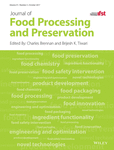Fatty Acid Profiles and Volatile Compounds Formation During Processing and Ripening of a Traditional Salted Dry Fish Product
Abstract
The present research aimed to investigate the chemical changes and volatiles formation during processing and ripening of a traditional dry salted fish product prepared from landlocked shad (Alosa fallax lacustris). Proximate and fatty acid composition, thiobarbituric acid reactive substances (TBARS) values, color measurements and volatile compounds were determined in fresh fish and salted samples at 9, 40, 70 and 100 days of maturation. The fatty acid composition changed during ripening, with significant increase of saturated fatty acids and decrease of monounsaturated fatty acids. The total concentration of volatile compounds increased rapidly from fresh fish to dried product, with a maximum peak in correspondence to the drying step. The TBARS values increased from 0.76 μg/g in fresh fish to 10.95 μg/g in dry fish. Lipolytic and proteolytic reactions occurring in salted product, exacerbated by the presence of high amount of salt and ambient ripening temperature, contributed to the development of typical flavors.
Practical Applications
In Europe there is a growing interest in traditional fish products derived from local species and prepared with ancient recipes. Shad is one of the major species harvested in subalpine lakes and most of captured fish are traditionally subjected to an artisanal processing procedure, to give a dried fish product that is commercialized with the historic name of missoltino. This study describes the quality changes of prepared shad during processing and ripening. The appropriate combination of salt, drying and ripening conditions allows to obtain a product with optimal chemical and sensory properties. This study aims to provide the fish producers with improved criterions to traditional practices, in order to standardize the process and to obtain higher quality product for consumers. Moreover, these results represent a basis for product valorization and could contribute to a better consideration of the product on the market.




